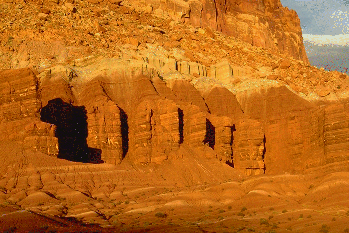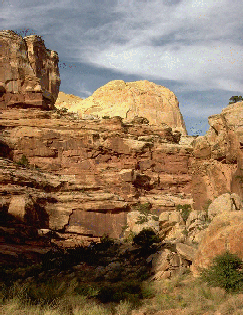The Geologic
Time Scale
in Historical Perspective

What is the origin of the geologic time scale?
The first people who needed to understand the geological relationships of different rock units were miners. Mining had been of commercial interest since at least the days of the Romans, but it wasn't until the 1500s and 1600s that these efforts produced an interest in local rock relationships.
By noting the relationships of different rock units, Nicolaus Steno in 1669 described two basic geologic principles. The first stated that sedimentary rocks are laid down in a horizontal manner, and the second stated that younger rock units were deposited on top of older rock units. To envision this latter principle think of the layers of paint on a wall. The oldest layer was put on first and is at the bottom, while the newest layer is at the top. An additional concept was introduced by James Hutton in 1795, and later emphasized by Charles Lyell in the early 1800s. This was the idea that natural geologic processes were uniform in frequency and magnitude throughout time, an idea known as the "principle of uniformitarianism".

What do the divisions of the geologic time scale signify?
 The history
of the earth is broken up into a hierarchical set of divisions for describing
geologic time. As increasingly smaller units of time, the generally accepted
divisions are eon, era, period, epoch, age. In the time scale shown at
left, only the two highest levels of this hierarchy are represented.
The history
of the earth is broken up into a hierarchical set of divisions for describing
geologic time. As increasingly smaller units of time, the generally accepted
divisions are eon, era, period, epoch, age. In the time scale shown at
left, only the two highest levels of this hierarchy are represented.
The Phanerozoic Eon is shown along the top left side of this figure and represents the time during which the majority of macroscopic organisms, algal, fungal, plant and animal, lived. When first proposed as a division of geologic time, the beginning of the Phanerozoic (approximately 543 million years ago) was thought to coincide with the beginning of life. In reality, this eon coincides with the appearance of animals that evolved external skeletons, like shells, and the somewhat later animals that formed internal skeletons, such as the bony elements of vertebrates. The time before the Phanerozoic is usually referred to as the Precambrian, and exactly what qualifies as an "eon" or "era" varies somewhat depending on whom you talk to. In any case, the Precambrian is usually divided into the three "eras" shown.
The Phanerozoic also consists of three major divisions...the Cenozoic, the Mesozoic, and the Paleozoic Eras. The "zoic" part of the word comes from the root "zoo", which means animal. This is the same root as in the words Zoology and Zoological Park (or Zoo). "Cen" means recent, "Meso" means middle, and "Paleo" means ancient. These divisions reflect major changes in the composition of ancient faunas, each era being recognized by its domination by a particular group of animals. The Cenozoic has sometimes been called the "Age of Mammals", the Mesozoic the "Age of Dinosaurs" and the Paleozoic the "Age of Fishes". This is an overly simplified view, which has some value for the newcomer but can be a bit misleading. For instance, other groups of animals lived during the Mesozoic. In addition to the dinosaurs, animals such as mammals, turtles, crocodiles, frogs, and countless varieties of insects also lived on land. Additionally, there were many kinds of plants living in the past that no longer live today. Ancient floras went through great changes too, and not always at the same times that the animal groups changed.
As you explore exhibits in tthe Geology Wing, you can often find out more about how the about divisions of the time scale were defined and named by clicking on the "Stratigraphy" button. For a good example, go to the Cenozoic Era stratigraphy page.
Further reading on this topic:
- Berry, W. 1987. Growth of a prehistoric time scale: based on organic evolution. Revised edition, Blackwell Scientific Publications, Palo Alto, 202p.
- Visit the excellent set of on-line course notes for Pamela J.W. Gore's Historical Geology class.



